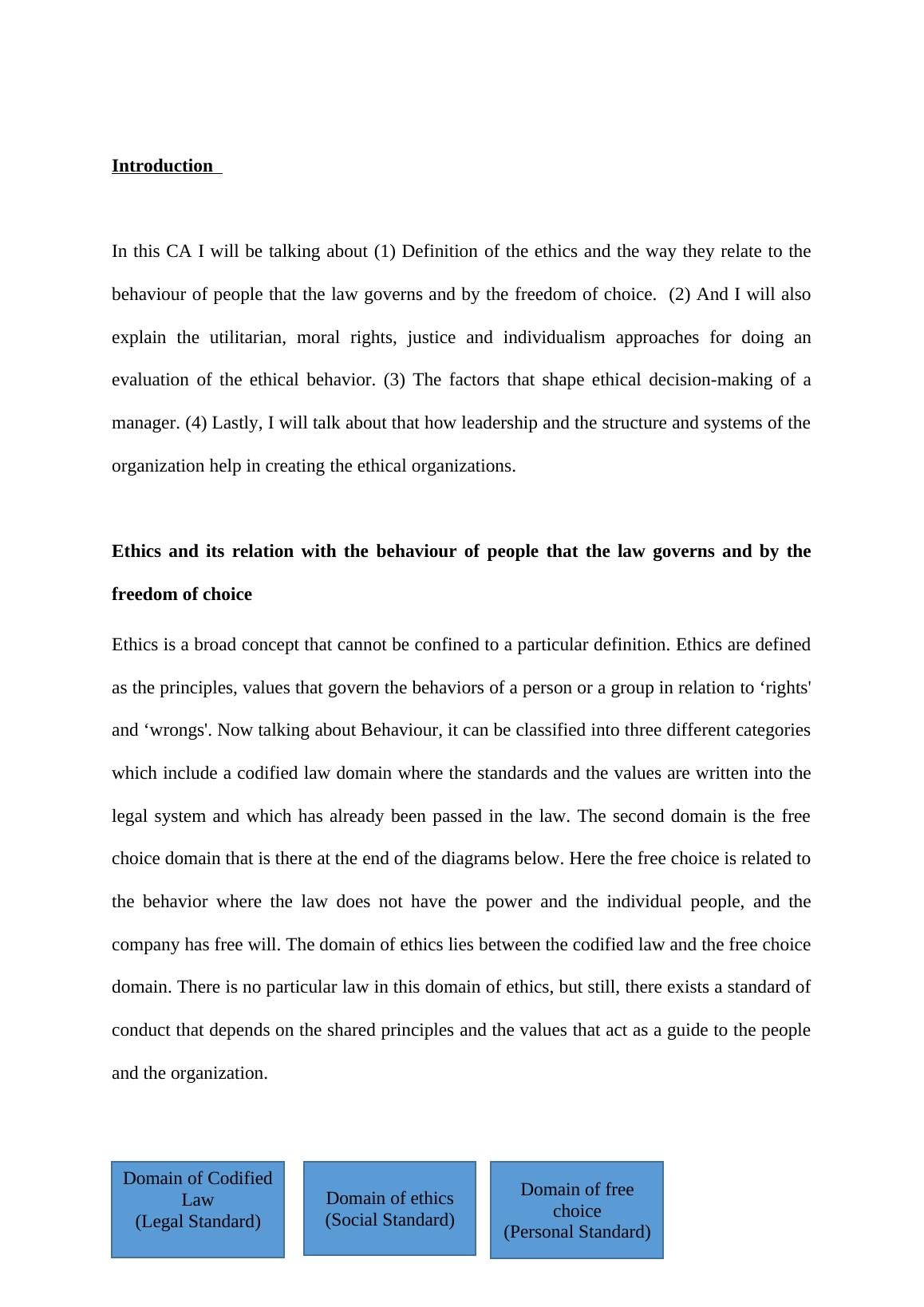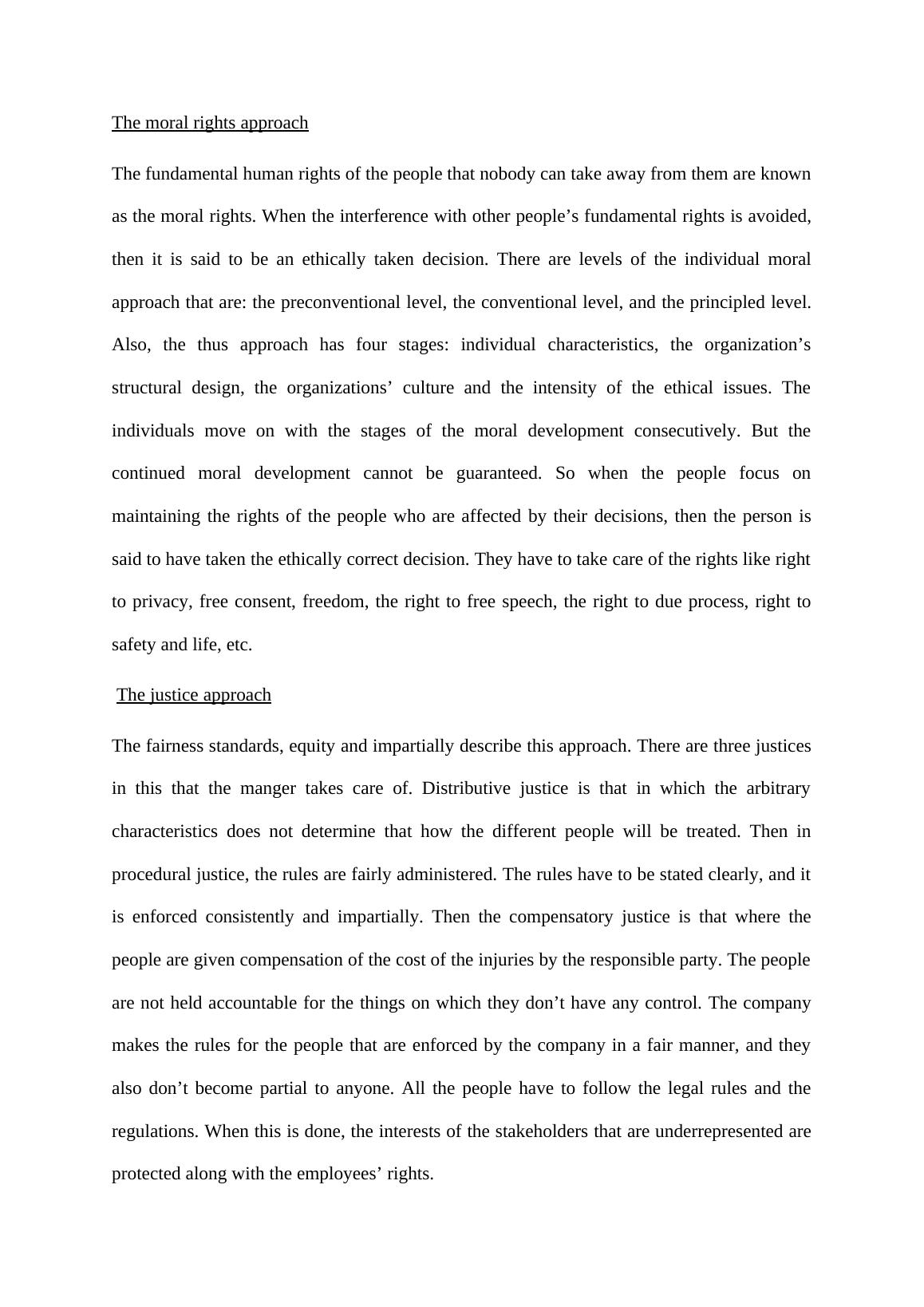Domain of codified law Assignment
Added on 2019-10-18
8 Pages1980 Words791 Views
Introduction In this CA I will be talking about (1) Definition of the ethics and the way they relate to thebehaviour of people that the law governs and by the freedom of choice. (2) And I will alsoexplain the utilitarian, moral rights, justice and individualism approaches for doing anevaluation of the ethical behavior. (3) The factors that shape ethical decision-making of amanager. (4) Lastly, I will talk about that how leadership and the structure and systems of theorganization help in creating the ethical organizations. Ethics and its relation with the behaviour of people that the law governs and by thefreedom of choiceEthics is a broad concept that cannot be confined to a particular definition. Ethics are definedas the principles, values that govern the behaviors of a person or a group in relation to ‘rights'and ‘wrongs'. Now talking about Behaviour, it can be classified into three different categorieswhich include a codified law domain where the standards and the values are written into thelegal system and which has already been passed in the law. The second domain is the freechoice domain that is there at the end of the diagrams below. Here the free choice is related tothe behavior where the law does not have the power and the individual people, and thecompany has free will. The domain of ethics lies between the codified law and the free choicedomain. There is no particular law in this domain of ethics, but still, there exists a standard ofconduct that depends on the shared principles and the values that act as a guide to the peopleand the organization. Domain of freechoice (Personal Standard)Domain of ethics (Social Standard)Domain of CodifiedLaw (Legal Standard)

High Low.Most dilemmas related to ethics involve conflict between the various needs of individuals andorganizations and in some cases, the organization and the entire society. The manager takesadvantage of the normative strategy for guiding their decision making. The approaches evaluating the ethical behaviour The utilitarian approachThe utilitarian approach holds moral behaviors to produce the most influential results inrelation to positive morals which can also be known as utilitarianism, a moral principle thatsays correct actions are that actions which give a greater amount of benefits than most of thepeople. The individualism approachThis Individualism approach can also be referred to as egoism, compete that acts are moral,positive or negative moral, when the best interest of an individual for a long time areencouraged. The people analyze that what is the best advantage to them for the long term andthen they evaluate it for measuring the decision’s goodness. That action should be performedwhich is producing a comparatively more proportion of good for the people than the otheralternatives.

The moral rights approachThe fundamental human rights of the people that nobody can take away from them are knownas the moral rights. When the interference with other people’s fundamental rights is avoided,then it is said to be an ethically taken decision. There are levels of the individual moralapproach that are: the preconventional level, the conventional level, and the principled level.Also, the thus approach has four stages: individual characteristics, the organization’sstructural design, the organizations’ culture and the intensity of the ethical issues. Theindividuals move on with the stages of the moral development consecutively. But thecontinued moral development cannot be guaranteed. So when the people focus onmaintaining the rights of the people who are affected by their decisions, then the person issaid to have taken the ethically correct decision. They have to take care of the rights like rightto privacy, free consent, freedom, the right to free speech, the right to due process, right tosafety and life, etc.The justice approachThe fairness standards, equity and impartially describe this approach. There are three justicesin this that the manger takes care of. Distributive justice is that in which the arbitrarycharacteristics does not determine that how the different people will be treated. Then inprocedural justice, the rules are fairly administered. The rules have to be stated clearly, and itis enforced consistently and impartially. Then the compensatory justice is that where thepeople are given compensation of the cost of the injuries by the responsible party. The peopleare not held accountable for the things on which they don’t have any control. The companymakes the rules for the people that are enforced by the company in a fair manner, and theyalso don’t become partial to anyone. All the people have to follow the legal rules and theregulations. When this is done, the interests of the stakeholders that are underrepresented areprotected along with the employees’ rights.

End of preview
Want to access all the pages? Upload your documents or become a member.
Related Documents
Factors Affecting Managerial Ethical Decision Makinglg...
|7
|1847
|151
NRSG257 Child, Adolescent and Family Nursing Reportlg...
|10
|3011
|220
Corporate Governance And Ethics Assesmentlg...
|9
|1788
|15
Case Study | Nursing Ethicslg...
|9
|2884
|43
Utilitarian Approach to Business Ethics Essaylg...
|13
|4044
|306
APES 110 Code of Ethics for Professional Assignment 2022lg...
|11
|3439
|21
